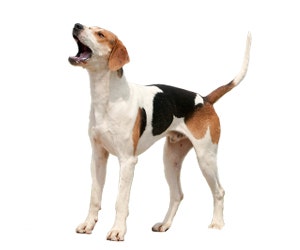American English Coonhound
-
Overview
American English Coonhounds are multi-purpose hunting dogs who are skilled at tracking raccoons, but also larger game like foxes, boars, bobcats, deer and bears. They stand about two feet tall and their lean, agile bodies should appear in proportion to their height.
-
Personality
These dogs are excellent tracking hounds who are effective at treeing their prey and have a single-minded approach to hunting. They are popular night-hunting companions because their nose is so strong, they can sniff out both large and small prey even in the dark. American English Coonhounds have a loud, melodious bark that helps alert their master to the game they've cornered, but it also makes them pesky apartment dwellers. These dogs do best in rural homes with plenty of space for them to stretch their legs and exercise their snouts. American English Coonhounds are strong-willed and easily distracted, so consistent, firm training that keeps them engaged is necessary from a young age. They are generally friendly, good-natured dogs with an excess of energy and a drive to explore and track game.
-
Coat Care
American English Coonhounds' have ticked coats in shades of red, white, blue and combinations of red and white or blue and white. Their coats are usually ticked in beautiful, watercolor-like patterns that help them stand out from other breeds of Coonhound. They have a hard, protective coat that is either medium length or short. They have long, straight tails that are held aloft as they hunt.

Groom your American English Coonhound with a rubber bristle brush to remove dead hairs.
Like all hounds, they can develop an odor, so both you and your dog will appreciate a routine bath once they start to smell.
Clipping or trimming your dog’s coat is far easier than you would ever imagine. With the right clipper, trimmer and scissors, giving your dog a haircut is easy on your wallet and your schedule.
Most dogs with short coats generally require occasional trims and tidying up in areas of excessive hair growth with trimmers or blunt scissors. It's always wise to take a dog for a short walk or exercise to calm them down before trimming. Remember to brush the coat first to remove tangles and mats. Use a trimmer or a scissors to even out areas around the tail, paws, sanitary areas and chest, as needed. When finished, the coat should lay flat and smooth against the body of most short-haired dogs.
Many dog owners are apprehensive about trimming their dog’s nails because they are nervous about cutting into the quick. But with the right conditioning and careful cutting, nail clipping can be a simple, stress-free activity for you and your dog.
Provide your dog with plenty of positive reinforcement and even treats to help associate nail clipping with a positive experience. As you start to clip, gently press on your dog’s paws to help him become accustomed to the feeling of having his nails clipped. Then, work gradually, shaving down just a thin portion of the nail at first to make sure you don’t reach the quick. Clip one nail, reward your dog with a treat, and stop to give him some positive reinforcement before moving on. Gradually increase the number of nails you clip in one sitting to help your dog get used to the process. Never trim extremely long nails down to a short nail in one sitting, because this is an excellent way to accidently quick the dog’s nail. Instead, work gradually, shaving small portions of your dog’s nails off each time.
You can tell if you’re getting close to the quick by the texture of your dog’s nail. The nail is hard closer to the surface and becomes softer as you get closer to the quick. If your dog’s nail starts to feel softer, that’s a good indication that you’re getting close to the quick.
Make sure to check their floppy ears weekly for infection.
Many owners do not realize how important it is to brush your pet’s teeth on a regular basis. Some dogs are prone to dental problems and sensitive teeth, especially small dogs with tiny teeth and dogs with special diets. These problems can be easily combatted with frequent brushing.
Cavities are rare with dogs but gum disease caused by tartar buildup is not, which is why they require regular brushing with toothpaste and a toothbrush formulated specifically for dogs. While daily brushing is ideal, doing so on a weekly basis will be a big help in avoiding the need to bring your dog to a veterinarian for a cleaning, which usually has to be done under sedation.

 India (English)
India (English)
 Middle East and Africa (English)
Middle East and Africa (English)
 South Africa (English)
South Africa (English)
 Australia (English)
Australia (English)
 Japan (日本語)
Japan (日本語)
 South East Asia (English)
South East Asia (English)
 Singapore (English)
Singapore (English)
 Europe (English)
Europe (English)
 United Kingdom (English)
United Kingdom (English)
 Argentina (Español)
Argentina (Español)
 Brazil (Portuguese)
Brazil (Portuguese)
 Colombia (Español)
Colombia (Español)
 Latin America (Español)
Latin America (Español)
 México (Español)
México (Español)
 Chile (Español)
Chile (Español)
 Peru (Español)
Peru (Español)
 Canada (English)
Canada (English)

